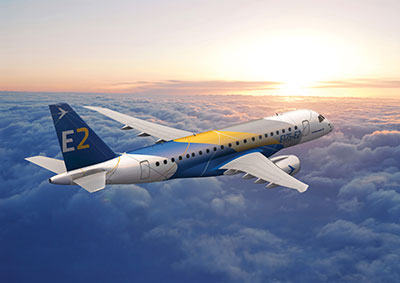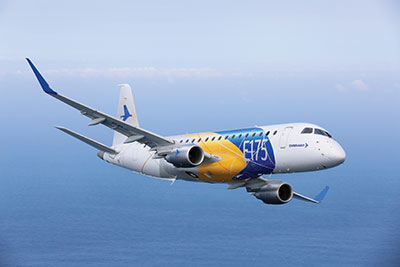
Features
Aircraft manufacturers
Embraer’s on the rise
In its nosewheel-to-nosewheel challenge with Bombardier for the position of the world’s third largest aircraft manufacturer
May 6, 2014 By Rick Adams
In its nosewheel-to-nosewheel challenge with Bombardier for the position of the world’s third largest aircraft manufacturer, Brazil-based Embraer regained its footing the past year and is hoping an array of new business and regional models will continue its upward trajectory.
 |
|
| The reworked E2 commercial jets will feature new wings, improved systems and avionics, including full fly-by-wire (FBW) flight controls, and Pratt & Whitney “PurePower” geared turbofan engines. Photo: Embraer |
“We cannot grow Bombardier out of the game,” president and CEO Frederico Curado told investment analysts. “They’re a strong company. We continue not to believe in the business case of the CSeries, but, you know, they have the CRJ line. They took about a quarter of the sales for the United States. We got three quarters. So instead of celebrating that we got three quarters, they’re still there, and we lost a quarter of the market to them.”
Embraer even surprised its Canadian rival in March by rolling out an enhanced version of its current E175 regional jet. The improvements feature new wingtips and streamlining of aerodynamic surfaces that are claimed to reduce fuel burn by 6.4 per cent compared to the previous production aircraft.
Embraer is stronger on the commercial aircraft ledger, delivering 90 aircraft in 2013 to Bombardier’s 55. But Bombardier has the edge on the business aviation side with 180 business aircraft deliveries last year to 119 for Embraer. Overall, the Canadian company delivered 238 aircraft to 209 for the Brazilians.
While generally preoccupied with each other, Embraer and Bombardier are also looking over their shoulders at new regional jet competitors Sukhoi, COMAC, Antonov, and Mitsubishi, all entering the lower end of the commercial jet market, which Airbus and Boeing have somewhat ceded by focusing on larger capacity narrowbody aircraft. The leading turboprop OEM, France-based ATR, caters exclusively to 50- and 74-seat models.
China’s ARJ21 has been delayed for more than seven years. COMAC’s main effort is on the C919, a 148 to 168 seat competitor due to enter service around 2016, but only one customer to date is based outside China. Russia’s initial foray into the regional jet market, the Sukhoi SuperJet 100, developed in partnership with Italy’s Alenia Aeronautica, has been a partial sales success, but service entry has been marred by a 2012 demo flight crash in Indonesia (blamed on pilot error) and a test flight belly landing in Iceland last July. Antonov’s’s Irkut MS21 is due to enter service in 2017 in three versions from 136 seats up to 230 seats. Mitsubishi’s MRJ is scheduled for delivery to launch Japanese customer ANA in 2017; the first flight is currently planned for 2015.
“We have to watch how the Russian Superjet performs outside the Russian environment,” Curado said. “Keeping in mind, of course, that the airplane is of the current generation, so we feel good about the ability to compete against the Superjet, and we feel really good about the E2 190 to compete against the Russian business jet.
“It’s the same with the Chinese. We respectfully believe that there will be some difficulty to sell that airplane abroad in large quantities, the ARJ21. And, again, that is also an airplane of the current technology. The E2 can really be a leap ahead.”
Embraer stabilizing
A year ago, Embraer’s backlog was less than two years’ worth of production. However, deals were signed with Republic Airways (American Eagle) in January for 47 E175 jets, United Continental in April for 30 E175s, SkyWest in April for 40 E175s (to be operated under the United Express brand), and up to 60 E175s from American Airlines in December (at the same time Bombardier received an American order for 30 CRJ900s).
 |
|
| Embraer surprised its Canadian rival, Bombardier, in March by rolling out an enhanced version of its current E175 regional jet. Photo: Embraer
|
The flurry of U.S. contracts raised concerns that Embraer is offering deep discounts to gain market share. Embraer’s 2013 earnings were also boosted by resolution of the American Airlines bankruptcy, negating provisions for a potential restructuring write-down by a key customer.
“The major headwind we have in 2014 is reduction in gross margins on the commercial jets,” Curado acknowledged. “So we intend to compensate that with better margins in executive aviation.”
By year-end, Embraer had firm orders for 429 commercial aircraft, of which 279 are for the current generation of E-Jets. Embraer now only needs to add another 150 to 250 orders to its backlog to sell out its production slots until the next-generation aircraft family – dubbed “E2” and announced at the June 2013 Paris Airshow – is rolled out between 2018 and 2020.
The new E2 jets are expected to provide more than 20 per cent improvement in fuel economy. Embraer will stagger the E175, E190, and E195 capacities at roughly 20-seat increments, enabling them to bridge most of the 70- to 130-seat jet market.
The reworked E2 commercial jets will feature new wings, improved systems and avionics, including full fly-by-wire (FBW) flight controls, and Pratt & Whitney “PurePower” geared turbofan engines. Embraer Commercial Aviation president and CEO Paulo Cesar Silva said the company’s strategy is to “offer all the benefits of a clean-sheet design, but with the reliability of a mature platform and commonality with current generation E-Jets.” Embraer will spend less than $2 billion in development using the upgrade path compared with more than $4 billion for the all-new Bombardier CSeries approach.
BizAv: living large
On the business aviation side, Embraer’s strength has been in the very light jet category. The company recently delivered the 300th version of the Phenom 100, and is approaching the 200-mark for the larger Phenom 300. But it’s the lower end of the BizAv market that continues to struggle the most. Industry-wide, light jet deliveries for the entire industry have fallen by more than half from their peak of over 600 jets in 2007.
“The [Phenom] 300 is really performing well, selling well, and has a strong pricing. We have this perfect situation in the 300 where we have the market leadership and the highest price in the segment,” Curado said. “The lower end of the market is still the weakest, in our point of view. We are favouring higher production on the Phenom 300 than the 100. We have a specific effort to increase the pricing on the Phenom 100, even if that costs us a slight reduction in production.”
The $9-million Phenom 300 has a six-occupant range of 1,971 nautical miles (3,650 kilometres), which is nonstop Montreal to Vancouver. The aircraft is capable of flying at 45,000 feet (13,716 metres), and is powered by two Pratt & Whitney Canada PW535E engines with 3,200 pounds of thrust each. The cockpit enables single-pilot operation and offers the advanced Prodigy Touch Flight Deck option.
New features on the $7-million entry-level Phenom 100, popular with owner-operators, include multi-function spoilers, new interior collections, and options such as more stowage space.
Legacy 500: the slow roll
Embraer has been investing heavily to round out its executive aircraft line, adding the Legacy 450 and 500 models in between the Phenoms and larger Legacy 600/650 and Lineage 1000 types.
When Embraer’s new Legacy 500 finally debuts later this year (a July forecast), it will be the first fly-by-wire (FBW) aircraft in the midsize business aviation class. The 500 was supposed to enter service in late 2013, but there have been some issues with its FBW maturity and the company is taking a cautious approach. Embraer wants to mature the systems in the factory rather than the field so any necessary improvements can be rolled into the design before ramping up production rates.
“We do have typical challenges of this final sprint of certification, which we’re still shooting for mid year,” Curado said. “It’s a slow ramp-up, deliberately slow [three to six deliveries expected in 2014]. We’re investing significantly in maturity of all systems. As you may recall, we did have some issues in the introduction of the Phenoms in the marketplace, which, of course, is more costly to improve the fleeting service than it is investing in maturity upfront. So we’ll have these airplanes flying very, very intensively. The idea is to have smooth ramp-up in the second semester and really make it steeper in 2015.”
The 500 delay, of course, sets back entry into service by 12 months for the Legacy 450 – a smaller version of the type with a reduced range. “The 450 inherits all the benefits of what we do in the 500,” said Curado. “The airplanes will have a very high degree of commonality. They’re fundamentally the same airplane. So the 450 seems to be even smoother, with all the lessons learned in the 12 months of operation with the 500. At this stage, we feel good.”
Part of the Legacy 500 certification conundrum in the United States has been a Federal Aviation Administration (FAA) attempt to retroactively apply a new “leg flail” regulation. The new 35 degree leg flail standard for side-facing seats (versus the old 45 degrees), adopted by the FAA in 2011, came two years after Embraer applied for a type certificate for the 500. However, no side-facing seat in the market currently meets the FAA’s new standard, according to Embraer, which has applied for an exemption. Without the exemption, Embraer will deliver the first 50 or so 500s with two side-facing seats which cannot be used during take-off or landing.
The Legacy 500 features the largest cabin volume and the only stand-up cabin with flat floor in its class. The interior has been designed in partnership with BMW design works USA.
The first Legacy 650 in China
Production on the Legacy 650 large business jet began last year through a joint venture with Chinese company Harbin Aircraft Manufacturing Corporation, part of the China Aviation Industry Corporation (AVIC) via which Embraer previously built ERJ 135, 140, and 145 regional aircraft models for the Chinese market. The 650 and 600 models are derivatives of the 145 family. All Legacy 650s assembled in Harbin will be delivered to customers in China.
 |
|
| Embraer’s president and CEO Frederico Curado is exited about where his company is headed. Photo: Embraer
|
The Legacy 650, with its ticket price of $33 million, comfortably carries up to 14 passengers and features advanced navigation capabilities as well as the Honeywell Primus Elite avionics suite. With four passengers, the Legacy 650 has a range of 3,900 nm (7,223 km) with four passengers, it can fly nonstop from Toronto to Rome. The 650 is powered by a pair of 9,020-pound thrust Rolls Royce AE 3007A2 engines.
The ultra-large category Lineage 1000E is Embraer’s largest executive jet. It can carry up to 19 passengers. With eight passengers and three crew, this aircraft’s range is 4,600 nm (8,519 km), which can it nonstop from Beijing to Vancouver. The Lineage 1000E is equipped with an electronic FBW flight control system. Options include Autoland, which conducts approach, touch down, and a five-second rollout when the autopilot is engaged, and the Embraer Enhanced Vision System (E2VS), which bundles head-up displays (HUD) and an EVS.
The $54-million Lineage 1000E was developed from the Embraer 170/190 commercial aircraft family, which has accumulated more than five million hours flown. Powered by GE CF34-10E7-8 engines with 18,500-lb maximum thrust, the aircraft will cruise at 472 knots (874 km/h) and has a landing distance of 2,450 feet (747 m).
Last October, Embraer announced the upgraded “E” version. The E stands for both extended range and enhanced interior. A 200 nm range extension is made possible by a 500-pound decrease in the basic empty weight, partially accomplished by replacing heavy hardwood interior accents with new materials. Passengers can enjoy on-board telephone systems, multiple ports, iPad docks, and iPad-controllable lighting systems. The bedroom has access to the massive luggage compartment, which Embraer claims is the largest in its class at 333 cubic feet.
Embraer even offers a highly customized “Skyacht” luxury option for the Lineage 1000E by which “experiential designer” SottoDesign Studios will personalize your aircraft “down to the most exquisite interior and exterior detail” in the finest tradition of an oceangoing vessel. The Lineage 1000E, of which 13 have been sold, primarily in the Middle East, competes with the Bombardier Global 7000/8000 and Gulfstream 550.
With its diverse family of both commercial and BizAv aircraft, Embraer has positioned itself very well for solid growth in 2014 and beyond.